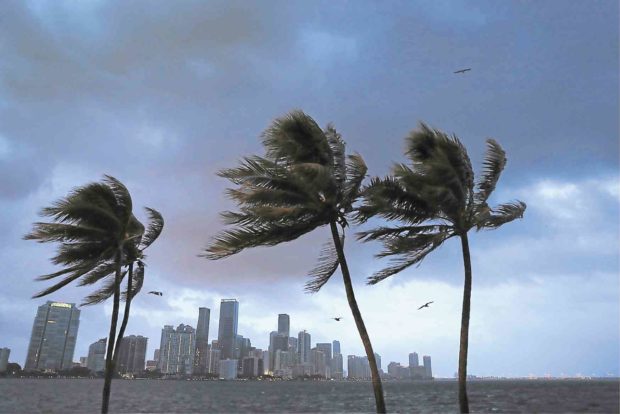
DOUBLE-BARREL THREAT Hurricane “Irma” is expected to bring a double-threat of destructive winds and life-threatening storm surges to Florida. —AFP
MIAMI, Florida — The storm surge created by Hurricane Irma is called dangerous and life-threatening, but what exactly is it?
It’s not a wall of water or a tsunami. Simply put, hurricane winds push water toward shore. It can happen quickly and far from a storm’s center, inundating areas that don’t typically flood.
A storm surge doesn’t just come from the ocean. It can come from sounds, bays and lakes, sometimes well inland.
Large hurricanes tend to create a greater storm surge over a broader area, and coastal features such as bays can act like funnels and back water up into rivers and canals, said Jamie Rhome, head of the US National Hurricane Center’s storm surge unit.
“This is going to sneak up on people,” Rhome said.
Forecasters say storm surges kill more people than strong winds. Florida Gov. Rick Scott said a storm surge “will cover your house.”
The National Hurricane Center forecasts water levels up to 4 meters (15 feet) above ground for the Florida Keys island chain and parts of the state’s Gulf Coast, along with up to 63 centimeters (25 inches) of rain in the Keys.
The flooding threat extended far beyond the path of Irma’s eye. The Atlantic coast from Miami to Isle of Palms, South Carolina, could see up to 2 meters (6 feet) of storm surge.
About 1,600 kilometers (1,000 miles) of coastline from Tampa Bay to the mid-South Carolina coast could see storm surge.
Much of that landscape lies less than 3 meters (10 feet) above sea level, and the surge from Irma could be a few centimeters higher in some areas.
Much of Florida’s southwest coast is uninhabited swampland, including a large section of Everglades National Park.
“The Everglades won’t stop the potential flooding to inhabited areas,” Rhome said.